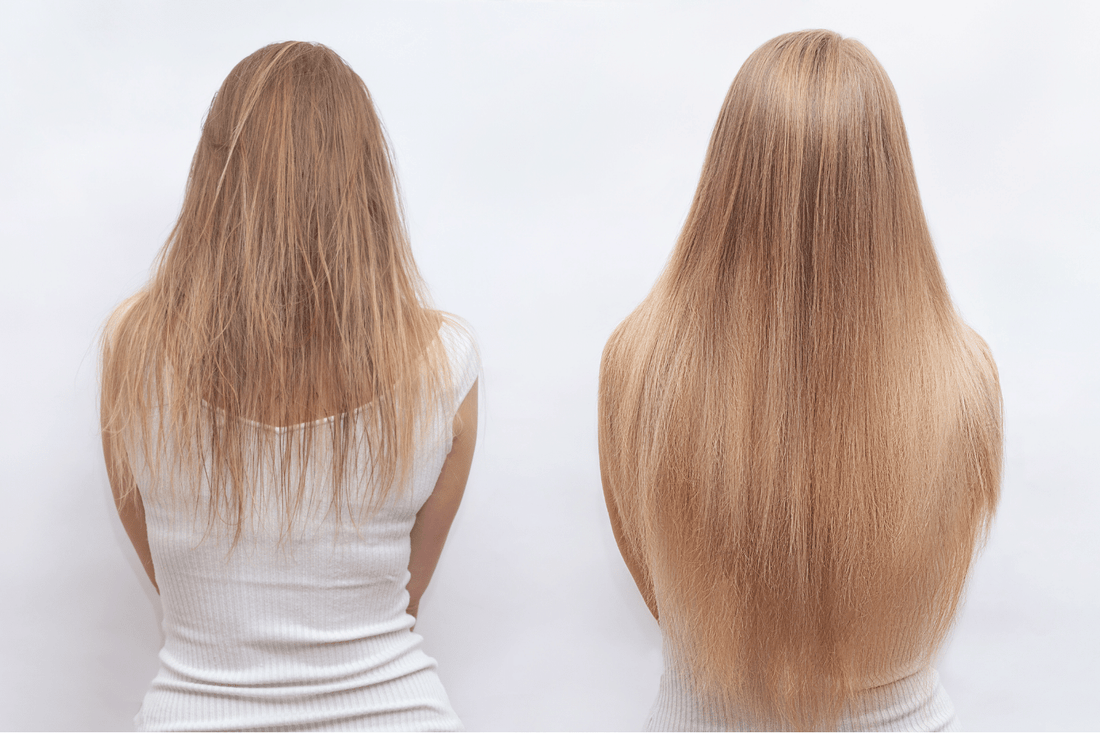If you’ve ever experienced hair loss, you probably also wondered both how to get it back and then also “how long does it take to regrow hair.” Read on to learn more about cycles of hair growth and what steps should be taken after hair loss in order to successfully recover.
What is a Hair Follicle?
“Hair” as a general term is made up of the follicle (which lies below the scalp) and the shaft, which is the visible part we generally refer to. The hair follicle is simply a section of the epidermis that tunnels down into the dermis layer of the skin. There are multiple layers in the construction, and each layer has a different purpose. The papilla, or small blood vessel, is located near the base of the follicle and contains capillaries, which provide the cells with nutrition. The bulb, which is located at the very bottom of the hair shaft and surrounds the papilla, is the live portion, and its cells divide more quickly than any other cell in the body.
We as humans have approximately one million follicles on our skulls, with about 10% of them located on the scalp. Follicle health is extremely important because they are not really regenerated throughout the course of our lifetimes.
What is the Hair Growth Cycle?
Humans grow hair at an average rate of a bout 0.3 to 0.4 millimeters per day, or about half an inch per month. Human hair growth and shedding, unlike that of other mammals, is not seasonal or cyclical, and so therefore a t any given time, a seemingly random number of hairs will be in one of three phases of growth and shedding: anagen, catagen, and telogen.
- Anagen. The active hair growth phase is influenced by heredity and can last anywhere from 3 to 6 years. The length of time hair can grow depends on how long it takes in the anagen phase. At any given time, approximately 90% of all hair follicles are in the anagen phase.
- Catagen. When the hair stops growing, the transitional catagen phase lasts between two and six weeks. At any given time, just 1% of all hair follicles are in this phase.
- Telogen. The resting phase, or telogen stage, of hair growth is when hairs actually fall out. This stage lasts between two and three months. The 50–100 hairs that fall out each day are caused by the remaining ~9% of hair follicles that are in the telogen phase.
How long does it take to regrow hair?
How long it takes to regrow hair depends on many factors, including how long you’d like it to be, the condition it is currently at, and the environment your hair is in, just to name a few. If your scalp does not require healing, the cycle will repeat within one to two months, u nless the damage is permanent, in which case no new hair will grow, it can take up to four years for your hair follicles to recover enough to renew regularly. Sometimes, follicles become miniaturized and dormant, which can either pause, stop, or significantly hinder the recovery process.
The typical monthly growth of hair is about half an inch, or about six inches per year. Numerous additional factors might also affect how rapidly your hair grows. Age, genetics, hormones, food, stress, illnesses, drugs, and even the season can all have an effect on how (and if) and how quickly your hair grows back after experiencing hair loss. As your body and physiology changes over the course of your life, your hair growth rate will change with it.
Can you make hair grow back faster?
Many people who are experiencing hair loss are interested in accelerating hair growth. Even those who do not experience hair loss may look for methods to hasten hair growth. Numerous products can even advertise or make claims regarding quicker hair development. Even though you can't always control the elements that affect how quickly your hair regrows, the good news is that you have access to a number of tools that can support the health of your hair and your body's capacity to encourage hair growth. The following are some examples of daily routine additions to help provide the optimum environment for hair revival:
- Eat enough protein. Keratin, which is the underlying building block of the hair shaft, is made of protein. If your body doesn't obtain enough protein, it will stop growing hair to conserve protein for other, more life-critical cells. Include things like meat, eggs, fish, beans, and nuts in your diet to nourish your hair follicles.
- Include iron in your diet. Iron deficiency can inhibit necessary body function, including healthy hair growth . Good sources of iron include red meat, beans, lentils, and dark green leafy vegetables, such as spinach.
- Be gentle with your hair. Avoid aggressive drying of damp hair with a towel. Use a wide-tooth comb on wet hair and avoid excessive tugging. When blow-drying your hair, use low heat settings to avoid damage. Limit tight-pulling hairstyles like buns and ponytails to avoid excess traction and stress on the follicles.
- Manage your stress. In order to maintain healthy hair, stress reduction has never been more crucial. Numerous exercises, like yoga and meditation, have been demonstrated to lower stress levels. However, you can also reduce stress by getting enough rest, joking with friends, and spending time outside.
- Use a hair serum. Using a a clinically tested hair serum can put your hair health game on the next level. Specially-designed ingredients discovered specifically for hair follicle activation can provide the optimum environment for growth and development of recovering hair.
Conclusion
Hair is an important part of our identity. Hair and follicle care is extremely important to ensure reliable, consistent, and healthy growth throughout our lifetimes. Read more of our blogs to learn more about how to keep your hair strong and healthy!





